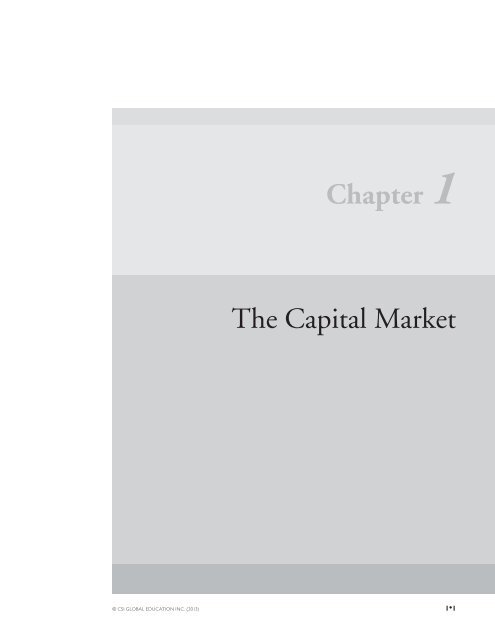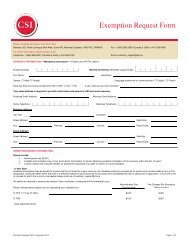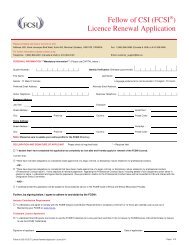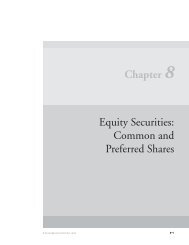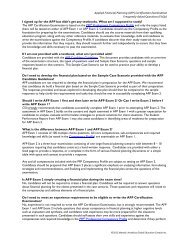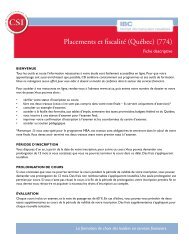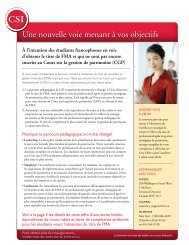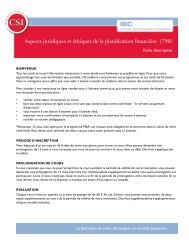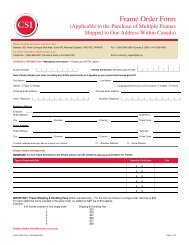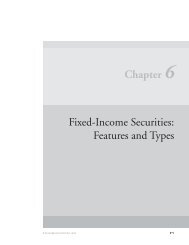Chapter 1 The Capital Market - CSI Global Education
Chapter 1 The Capital Market - CSI Global Education
Chapter 1 The Capital Market - CSI Global Education
You also want an ePaper? Increase the reach of your titles
YUMPU automatically turns print PDFs into web optimized ePapers that Google loves.
KEY TERMSAlternative trading systems (ATSs)Auction marketCanadian National Stock Exchange (CNSX)Canadian Unlisted Board Inc. (CUB)CanDealCanPX<strong>Capital</strong>CBIDCommon sharesDealer marketsDebtDerivativeEquityICE Futures CanadaInstitutional InvestorsInvestment advisors (IAs)Investment fund<strong>Market</strong> capitalization<strong>Market</strong> makersMutual fundMontreal Exchange (ME)Open-end fundOptionPreferred sharesPrimary marketQuotation and trade reporting systems (QTRS)Retail investorsSecondary marketStock exchangeToronto Stock Exchange (TSX)TSX Venture Exchange1•4© <strong>CSI</strong> GLOBAL EDUCATION INC. (2013)
ONE • THE CAPITAL MARKET 1•5WHAT IS INVESTMENT CAPITAL?In general terms, capital is wealth – both real, material things such as land and buildings, andrepresentational items such as money, stocks and bonds. All of these items have economic value.<strong>Capital</strong> represents the invested savings of individuals, corporations, governments and many otherorganizations and associations. It is in short supply and is arguably the world’s most importantcommodity.<strong>Capital</strong> savings are useless by themselves. Only when they are harnessed productively do they gaineconomic significance. Such utilization may take the form of either direct or indirect investment.<strong>Capital</strong> savings can be used directly by, for example, a couple investing their savings in a home;a government investing in a new highway or hospital; or a domestic or foreign company payingstart-up costs for a plant to produce a new product.<strong>Capital</strong> savings can also be harnessed indirectly through the purchase of such representationalitems as stocks or bonds or through the deposit of savings in a financial institution. <strong>The</strong> indirectinvestment process is the principal focus of this course.Indirect investment occurs when the saver buys the securities issued by governments andcorporations, who in turn use the funds for direct productive investment – equipment, supplies,etc. Such investment is normally made with the assistance of the retail or institutional salesdepartment of the investment advisor’s firm.Characteristics of <strong>Capital</strong><strong>Capital</strong> has three important characteristics. It is mobile, sensitive to its environment and scarce.<strong>The</strong>refore capital is extremely selective. It attempts to settle in countries or locations wheregovernment is stable, economic activity is not over-regulated, the investment climate is hospitableand profitable investment opportunities exist. <strong>The</strong> decision as to where capital will flow is guidedby country risk evaluation, which analyzes such things as:<strong>The</strong> politicalenvironment:Economic trends:Fiscal policy:Monetary policy:Investmentopportunities:Characteristics ofthe labour force:whether the country is involved or likely to be involved in internal orexternal confl ictgrowth in gross domestic product, infl ation rate, levels of economicactivity, etc.levels of taxes and government spending and the degree to which thegovernment encourages savings and investmentthe sound management of the growth of the nation’s money supply andthe extent to which it promotes price and foreign exchange stabilityopportunities for investment and satisfactory returns on investmentwhen considering the risks to be acceptedwhether it is skilled and productive© <strong>CSI</strong> GLOBAL EDUCATION INC. (2013)
1•6CANADIAN SECURITIES COURSE • VOLUME 1Because of its mobility and sensitivity, capital moves in or out of countries or localities inanticipation of changes in taxation, exchange policy, trade barriers, regulations, governmentattitudes, etc. It moves to where the best use can be made of it and attempts to avoid areas wherethe above factors are not positive. Thus, capital moves to uses and users that offer the highestrisk-adjusted returns. <strong>Capital</strong> is scarce worldwide and is in great demand everywhere.Why <strong>Capital</strong> Is NeededAn adequate supply of capital is essential for Canada’s future well-being. Enough new andefficient plant and equipment must be put in place to ensure expanded output capability,improved productivity, increased competitiveness and the development of innovative, soughtafternew products. If capital investment is inadequate, the result will be insufficient output,declining productivity, rising unemployment, decreasing competitiveness in domestic andinternational markets – in short, lower living standards.<strong>The</strong> securities industry attaches great importance to the savings and investment process. It isconstantly in touch with governments with a view to improving the saving and investmentprocess. <strong>The</strong> industry advocates changes, when appropriate, in both government policies and thetax system. <strong>The</strong>se proposed changes are designed to encourage more saving and the investment ofsavings in productive plant and equipment.WHO ARE THE SOURCES AND USERS OF CAPITAL?<strong>The</strong> only source of capital is savings. When revenues of non-financial corporations, individuals,governments and non -residents exceed their expenditures, they have savings to invest.Non-financial corporations, such as steel makers, food distributors and machinery manufacturers,have historically generated the largest part of total savings mainly in the form of earnings, whichthey retain in their businesses. <strong>The</strong>se internally generated funds are usually available only forinternal use by the corporation and are not normally invested in other companies’ stocks andbonds. Thus, corporations are not important providers of permanent funds to others in thecapital market.Individuals may decide, especially if given incentives to do so, to postpone consumption nowin order to save so that they can consume in the future. Governments that are able to operate ata surplus are “savers” and able to invest their surpluses. Other governments are “dis-savers” andmust borrow in capital markets to fund their deficits.Non-residents, both corporations and private investors, have long regarded Canada as a goodplace to invest. Canada has traditionally relied on savings for both direct plant and equipmentinvestment in Canada and portfolio investment in Canadian securities.© <strong>CSI</strong> GLOBAL EDUCATION INC. (2013)
ONE • THE CAPITAL MARKET 1•7Sources of <strong>Capital</strong>Retail, institutional, and foreign investors are a significant source of investment capital.Retail investors:Institutionalinvestors:Foreign investors:Retail investors are individual investors who buy and sell securities for theirown personal accounts, and not for another company or organization.Institutional investors are organizations, such as a pension fund or mutualfund company, that trade large volumes of securities and typically have asteady fl ow of money to invest. Retail investors generally buy in smallerquantities than larger, institutional investors.Foreign investors also are a signifi cant source of investment capital.Historically, Canada has depended upon large infl ows of foreign investmentfor continued growth. Foreign direct investment in Canada has tended toconcentrate in particular industries: manufacturing, petroleum and natural gas,and mining and smelting. Some industries also have restrictions with respectto foreign investment.Users of <strong>Capital</strong>Based on the simplest categorization, the users of capital are individuals, businesses andgovernments. <strong>The</strong>se can be both Canadian and foreign users. <strong>The</strong> ways in which these groups usecapital are described below.INDIVIDUALSIndividuals may require capital to finance housing, consumer durables (e.g., automobiles,appliances) or other types of consumption. <strong>The</strong>y usually obtain it through incurring indebtednessin the form of personal loans, mortgage loans or charge accounts. Since individuals do not issuesecurities to the public and the focus of this text is on securities, individual capital users are notdiscussed further.Just as foreign individuals, businesses or governments can supply capital to Canada, capitalcan flow in the other direction. Foreign users (mainly businesses and governments) may accessCanadian capital by borrowing from Canadian banks or by making their securities available tothe Canadian market. Foreign users will want Canadian capital if they feel that they can accessthis capital at a less expensive rate than their own currency. Access to foreign securities benefitsCanadian investors, who are thus provided with more choice and an opportunity to furtherdiversify their investments.BUSINESSESCanadian businesses require massive sums of capital to finance day-to-day operations, to renewand maintain plant and equipment as well as to expand and diversify activities. A substantial partof these requirements is generated internally (e.g., profits retained in the business), while some isborrowed from financial intermediaries (principally the chartered banks). <strong>The</strong> remainder is raisedin securities markets through the issuance of short-term money market paper, medium- and longtermdebt, and preferred and common shares.© <strong>CSI</strong> GLOBAL EDUCATION INC. (2013)
1•8CANADIAN SECURITIES COURSE • VOLUME 1GOVERNMENTSGovernments in Canada are major issuers of securities in public markets, either directly orthrough guaranteeing the debt of their Crown corporations.FederalGovernmentProvincialGovernmentsWhen revenues fail to meet expenditures and/or when large capital projectsare planned, the federal government must borrow. <strong>The</strong> government makes useof four main instruments: treasury bills (T-bills), marketable bonds, CanadaSavings Bonds (CSBs) and Canada Premium Bonds (CPBs).Like the federal government, the provinces issue debt directly themselves.When revenues fail to meet expenditures and/or when large capital projectsare planned, provinces must borrow. <strong>The</strong>y may issue bonds to the federalgovernment or borrow funds from Canada Pension Plan (CPP) assets (or theQuébec Pension Plan in the case of Québec).Alternatively, a province may issue debt domestically through a syndicateof investment dealers who sell the issue to fi nancial institutions or to retailinvestors. In addition to conventional debt issues, some provinces issue theirown short-term treasury bills and, in some cases, their own savings bondssimilar to CSBs issued by the federal government.MunicipalGovernmentsMunicipalities are responsible for the provision of streets, sewers,waterworks, police and fi re protection, welfare, transportation, distributionof electricity and other services for individual communities. Since many ofthe assets used to provide these services are expected to last for twenty ormore years, municipalities attempt to spread their cost over a period of yearsthrough the issuance of instalment debentures (or serial debentures).Complete the following Online Learning ActivitySources and Users of <strong>Capital</strong>What is capital used for and where does it come from?Assess your understanding of the Sources and Users of <strong>Capital</strong>.© <strong>CSI</strong> GLOBAL EDUCATION INC. (2013)
ONE • THE CAPITAL MARKET 1•9WHAT ARE THE FINANCIAL INSTRUMENTS?Transferring money from one person to another may seem relatively straightforward. Why thendo we need formal financial instruments called securities?As a way of distributing capital in a large, sophisticated economy, securities have manyadvantages. Securities are formal, legal documents, which set out the rights and obligationsof the buyers and sellers. <strong>The</strong>y tend to have standard features, which facilitates their trading.Furthermore, there are many types of securities, enabling both investors (buyers) and users(sellers) of capital to meet their particular needs.Financial instrumentsMuch of this text deals with the characteristics of different financial instruments. <strong>The</strong> followingbrief discussion of instruments is included here to remind the reader that financial instruments(products) are one of the three key components of the securities industry. Financial instruments,along with the other two components, financial markets and financial intermediaries, will becovered in subsequent chapters.DebtInstruments:EquityInstruments:Debt instruments formalize a relationship in which the issuer promises torepay the loan at maturity and in the interim makes interest payments to theinvestor. <strong>The</strong> term of the loan ranges from very short to very long, dependingon the type of instrument. Bonds, debentures, mortgages, treasury bills andcommercial paper are all examples of debt instruments (also referred to asfi xe d - i n c o m e se c u r i t i e s).) .Equities are usually referred to as stocks or shares because the investoractually buys a “share” of the company, thus gaining an ownership stake in thecompany. As an owner, the investor participates in the corporation’s fortunes.If the company does well, the value of the company may increase, giving theinvestor a capital gain when the shares are sold. In addition, the company maydistribute part of its profi t to shareowners in the form of dividends. Unlikeinterest on a debt instrument, however, dividends are not obligatory.Different types of shares have different characteristics and confer differentrights on the owners. In general, there are two main types of stock: commonand preferred.InvestmentFunds:An investment fund is a company or trust that manages investments forits clients. <strong>The</strong> most common form is the open-end fund, also known as amutual fund. <strong>The</strong> fund raises capital by selling shares or units to investors,and then invests that capital. As unitholders, the investors receive part of themoney made from the fund’s investments.© <strong>CSI</strong> GLOBAL EDUCATION INC. (2013)
1•12CANADIAN SECURITIES COURSE • VOLUME 1• In the secondary market investors trade securities that have already been issued bycompanies and governments. In this market, buyers and sellers trade among each otherat a price that is mutually beneficial to both parties. <strong>The</strong> security is then transferred fromthe seller to the buyer. <strong>The</strong> issuing company does not receive any of the proceeds fromtransactions in the secondary market - the issuer received payment when the securities werefirst issued in the primary market.Auction <strong>Market</strong>s in Canada<strong>Market</strong>s can also be divided into auction and dealer markets. In an auction market, buyers enterbids and sellers enter offers for a stock. <strong>The</strong> price at which a stock is traded represents the highestprice the buyer is willing to pay and the lowest price the seller is willing to accept. <strong>The</strong>se ordersare than channelled to a single central market and compete against each other.<strong>The</strong>re are a number of important terms you need to understand when talking about tradingstocks.• <strong>The</strong> bid is the highest price a buyer is willing to pay for the security being quoted.• <strong>The</strong> offer (or ask) is the lowest price a seller will accept.• <strong>The</strong> spread is the difference between the bid and ask prices.• <strong>The</strong> last price is the price at which the last trade on that stock took place. This price canfluctuate back and forth between the bid price and the ask price as buying and selling ordersare filled. <strong>The</strong> last price is also referred to as the market price. It is important to understandthat the last price may not reflect the price for which you can currently buy or sell the stock,and only reflects the latest price at which a purchase or sale occurred.Let’s see how this terminology is used on the Toronto Stock Exchange.EXHIBIT 1.1AUCTION MARKETS IN ACTIONLet’s say there are three investors who want to buy a share of ABC and they enter the following bidson the stock: $5, $5.03 and $5.06. On the other side of the trade, there are three investors that wantto sell their share in ABC. <strong>The</strong>se sellers submit offers to sell their ABC stock at the following prices:$5.06, $5.07, and $5.11.<strong>The</strong> trade is executed and settles only when there is a match in the bid and offer prices.On the ABC trade, the investor who entered the bid and the seller who entered the offer of $5.06 willhave their orders executed. <strong>The</strong> other bid/offers will not be immediately executed. In fact, the price of$5.06 becomes the last price (or market price) of ABC.CANADIAN STOCK EXCHANGESA stock exchange is a marketplace where buyers and sellers of securities meet to trade with eachother and where prices are established according to the laws of supply and demand. On Canadianexchanges, trading is carried on in common and preferred shares, rights and warrants, listed© <strong>CSI</strong> GLOBAL EDUCATION INC. (2013)
ONE • THE CAPITAL MARKET 1•13options and futures contracts, instalment receipts, exchange-traded funds (ETFs), income trusts,and a few convertible debentures. On some U.S. and European exchanges, bonds and debenturesare traded along with equities.Liquidity is fundamental to the operation of an exchange. A liquid market is characterized by:• Frequent sales• Narrow price spread between bid and ask prices• Small price fluctuations from sale to saleCanada’s stock exchanges are auction markets. During trading hours, Canada’s exchanges receivethousands of buy and sell orders from all parts of the country and abroad.Canada has five exchanges: the Toronto Stock Exchange (TSX) and the TSX VentureExchange, the Montreal Exchange (MX, also known as the Bourse de Montréal), owned bythe TMX Group Inc., the Canadian National Stock Exchange (CNSX), and the ICE FuturesCanada. Each exchange is responsible for the trading of certain products.• <strong>The</strong> TSX lists senior equities, some debt instruments that are convertible into a listed equity,income trusts and Exchange-Traded Funds (ETFs).• <strong>The</strong> TSX Venture Exchange trades junior securities and a few debenture issues.• CNSX trades securities of emerging companies.• <strong>The</strong> Montreal Exchange trades all financial and equity futures and options.• ICE Futures Canada trades agricultural futures and options.EXHIBIT 1.2CHANGES TO THE CANADIAN EXCHANGESSecurities trading has existed in Canada since 1832. Over the years there have been many changes.<strong>The</strong> late 1990s saw radical changes to securities trading in Canada. In March 1999, Canada’s four majorstock exchanges announced that they had reached an agreement to restructure along lines of marketspecialization. <strong>The</strong> restructuring was intended to ensure a strong and globally competitive marketsystem, and this resulted in three specialized exchanges:• <strong>The</strong> Toronto Stock Exchange became Canada’s senior equities market and gave up its participationin derivatives trading and the junior equity market.• <strong>The</strong> Alberta Stock Exchange, the Winnipeg Stock Exchange and the Vancouver Stock Exchangemerged to create a single, national junior equities market, called the Canadian Venture Exchange(CDNX). This new market also consolidated the operations of the Canadian Dealing Network(CDN) as of October 2000.• <strong>The</strong> Montréal Exchange became the exclusive exchange for fi nancial futures and options in Canada.Responsibility for all equities once traded on Montréal transferred to the TSX or the TSX VentureExchange.© <strong>CSI</strong> GLOBAL EDUCATION INC. (2013)
1•14CANADIAN SECURITIES COURSE • VOLUME 1EXHIBIT 1.2CHANGES TO THE CANADIAN EXCHANGES – Cont’d<strong>The</strong> CDNX became a wholly owned subsidiary of the Toronto Stock Exchange in 2001. In April 2002,the Toronto Stock Exchange rebranded its abbreviated name from the TSE to TSX, while CDNXwas renamed the TSX Venture Exchange. <strong>The</strong>se changes were part of a rebranding initiative as theTSX and its subsidiaries prepared to go public in the fall of 2002. Under the rebranding program, theTSX, TSX Venture Exchange and TSX <strong>Market</strong>s Inc. (the arm of the TSX that sell market informationand trading services) are collectively known as the TSX Group of companies. In November 2002, theTSX Group Inc. went public, becoming the fi rst listed stock exchange in North America.In 2004, the CNSX gained recognition as a stock exchange by the Ontario Securities Commission.<strong>The</strong> intent of CNSX is to provide an alternative market to the TSX Venture Exchange for emergingcompanies.Trading on CNSX is also regulated by IIROC in the same way as the other Canadian exchanges andmust therefore follow the Universal <strong>Market</strong> Integrity Rules (UMIR).In 2007, the Winnipeg Commodity Exchange became a wholly-owned subsidiary of ICE and becameICE Futures Canada. This exchange trades options and futures of agricultural commodities such asCanola, Barley, and Wheat.In 2008, the TSX and the Montreal Exchange merged to form the TMX Group.In 2012, the Maple Group acquired the TMX Group Inc. As a result, the Maple Group was renamedTMX Group Limited.<strong>The</strong>re are over 80 stock exchanges in over 60 countries around the world. Including the auctionmarkets in Canada, North America has 10 exchanges, Europe has in excess of 35, Central andSouth America, around 10, and the balance are in Africa, Asia and Australia.Dealer <strong>Market</strong>sDealer markets are the second major type of market on which securities trade. <strong>The</strong>y consist ofa network of dealers who trade with each other, usually over the telephone or over a computernetwork. Unlike auction markets, where the individual buyer’s and seller’s orders are entered, adealer market is a negotiated market where only the dealers’ bid and ask quotations are entered bythose dealers acting as market makers in a particular security.<strong>Market</strong> makers work for investment dealers and must be approved by the exchange to carry outmarket making duties on assigned stocks. <strong>The</strong> responsibilities include monitoring the opening oftrading to ensure that orders are properly executed, maintaining a continuous two-sided market at anagreed upon maximum spread throughout the day (e.g., $0.10 between the bid and ask), and executingall tradable orders that meet a maximum number of shares as agreed upon with the exchange. Bymaking a market, the market maker assists in creating fair and orderly markets and contributes tomarket liquidity for all parties who want to participate in the buying and selling of stocks.© <strong>CSI</strong> GLOBAL EDUCATION INC. (2013)
ONE • THE CAPITAL MARKET 1•15Almost all bonds and debentures are sold through dealer markets. <strong>The</strong>se dealer markets areless visible than the auction markets for equities, so many people are surprised to learn that thevolume of trading (in dollars) on the dealer market for debt securities is significantly larger thanthe equity market.Dealer markets are also referred to as over-the-counter (OTC) or as unlisted markets - securitieson these markets are not listed on an organized exchange as they are on auction markets.THE UNLISTED EQUITY MARKET<strong>The</strong> volume of unlisted equity business is much smaller than the volume of stock exchangetransactions. <strong>The</strong> exact size of Canadian OTC dealings cannot be measured because completestatistics are not available. Many junior issues trade OTC, but so too do the shares of a fewconservative industrial companies whose boards of directors have for one reason or another decidednot to seek stock exchange listing for one or more issues of their equities. <strong>The</strong> unlisted market doesnot set listing requirements for the stocks traded on its system (hence the term “unlisted market”)nor does it attempt to regulate the companies. Many of the stocks sold on the unlisted market aremore speculative, and in most cases offer lower liquidity, than listed securities.TRADING IN THE UNLISTED MARKETOver-the-counter trading in equities is conducted in a similar manner to bond trading. Oneveteran described the OTC market as a “market without a market place.” In the OTC market,individual investors’ orders are not entered into the market or displayed on the computer system.Instead, dealers, who are acting as market makers, enter their bid and ask quotations. <strong>The</strong>semarket makers hold an inventory of the securities in which they have agreed to “make a market.”<strong>The</strong>y sell from this inventory to buyers and add to the inventory when they acquire securitiesfrom sellers.<strong>The</strong> market makers post their individual bid (the highest price the maker will pay) and ask (thelowest price the maker will accept) quotations. <strong>The</strong> willingness of the market makers to quotebid and ask prices provides liquidity to the system (although the market makers do have the rightto refuse to trade at these prices). When an investor wishes to buy or sell an unlisted security,the broker consults the bid/ask quotations of the various market makers to identify the bestprice, and then contacts the market maker to complete the transaction. <strong>The</strong> broker charges acommission for this service.OVER-THE-COUNTER DERIVATIVES MARKETDerivatives also trade in dealer or OTC markets. <strong>The</strong> OTC derivative market is dominated byfinancial institutions, such as banks and brokerage houses, who trade with other corporate clientsand other financial institutions. This market has no trading floor and no regular trading hours.Traders do not meet in person to negotiate transactions and the market stays open 24 hours a day.One of the attractive features of OTC derivative products is that they can be custom designedby the buyer and seller. As a result, these products tend to be somewhat more complex, as specialfeatures are added to the basic properties of options and forwards.© <strong>CSI</strong> GLOBAL EDUCATION INC. (2013)
1•16CANADIAN SECURITIES COURSE • VOLUME 1REPORTING TRADES IN THE UNLISTED MARKETIn most of Canada, there is no requirement for firms to report unlisted trades. Ontario is theexception. <strong>The</strong> Ontario Securities Commission (OSC) requires that trades of unlisted securitiesbe reported through the Canadian Unlisted Board Inc. (CUB). CUB was launched as anautomated system after the reorganization of the equity markets in Canada. It offers an Internetweb-based system for dealers to report completed trades in unlisted and unquoted equitysecurities in Ontario, as required under the Ontario Securities Act.Other Trading SystemsOver time, different trading systems emerged to meet changing investor needs. Examples includequotation and trade reporting systems and alternative trading systems (ATSs).QUOTATION AND TRADE REPORTING SYSTEMSQuotation and trade reporting systems (QTRS) are entities, other than an exchange orregistered dealer, that disseminate price quotations for the purchase and sale of securities andreport completed transactions to the applicable securities commission. A QTRS must berecognized by a provincial securities regulatory authority.ALTERNATIVE TRADING SYSTEMSAlternative trading systems (ATSs) are privately owned computerized trading facilities thatmatch buy and sell orders for securities traded outside of recognized exchanges. ATSs can beowned by individual brokerage firms or by groups of brokerage firms.<strong>The</strong>se systems compete with the exchanges because a brokerage firm operating an ATS can matchorders directly from its own inventory, or act as an agent in bringing buyers and sellers together,thus bypassing the stock exchange. Since there is one less intermediary, more of the commissioncharged to the client is kept by the dealer. Most client users of these systems are institutionalinvestors who can reduce transaction costs considerably and avoid the market impact of theirtrades if the orders were instead traded through a regular exchange. Some non-brokerage-ownedATSs even allow buyers and sellers to contact each other directly and negotiate a price.Equity ATSs now in operation in Canada include CNSX’s Pure Trading, Bloomberg Tradebook Canada,OMEGA ATS, Chi-X Canada, Instinet Canada Cross ICX, Liquidnet Canada, and MATCH Now,operated by TriAct Canada <strong>Market</strong>place LP.Alternative trading systems have the potential, however, to threaten market stability due tolessened market transparency, cross-border trading issues and technological glitches such asinsufficient system capacity. In Canada, ATSs are members of the Investment Industry RegulatoryOrganization of Canada (IIROC). <strong>The</strong> trading activity of ATS is also regulated by IIROC.Fixed-Income Electronic Trading SystemsWith the exception of a few debentures listed on the TSX and TSX Venture Exchanges, all bondand money market securities are sold through dealer markets. Three fixed-income electronictrading systems launched in Canada include:© <strong>CSI</strong> GLOBAL EDUCATION INC. (2013)
ONE • THE CAPITAL MARKET 1•17CANDEALCanDeal, a member of IIROC, is a joint venture between Canada’s six largest investment dealers,and is operated by the TMX Group. It is recognized as both an ATS and an investment dealer.It offers institutional investors access to Government securities and to money market instruments.CBIDCBID, also a member of IIROC and an ATS, operates two distinct fixed-income marketplaces:retail and institutional. <strong>The</strong> retail fixed-income marketplace is accessible by registered dealerson behalf of retail clients. <strong>The</strong> institutional fixed-income marketplace is accessible by registereddealers, institutional investors, governments and pension funds.CANPXCanPX is a joint venture of Investment Industry Association of Canada (IIAC)/IIROC dealermember firms. <strong>The</strong> CanPX system is an information processor for government and corporatedebt securities that provides investors with real-time bid and offer prices and hourly trade data.<strong>The</strong> service covers Government of Canada bonds, treasury bills, and provincial bonds, and aselect list of corporate bonds from major industrial issuers.Complete the following Online Learning ActivityAuction and Dealer <strong>Market</strong>sYou have read about the differences between dealer markets and auctionmarkets. Use this exercise to assess your understanding of the features ofthese markets.Complete the Auction and Dealer <strong>Market</strong>s activity that outlinesthe features of these markets.Trends in Financial <strong>Market</strong>s<strong>The</strong>re have been many changes to global capital markets over the last several years:• ATSs are taking market share away from traditional stock exchanges.• Exchanges are merging and taking over other exchanges to meet the challenge ofglobalization. Ten years ago, there were over 200 exchanges in the world; today there arefewer than 100.• In addition to mergers and takeovers, exchanges are forming alliances, partnerships andelectronic links with exchanges in other countries to foster global trading.Most of these changes were driven by increased global trading, aggressive competition, the ease ofelectronic communication, improved computer technology and the increased mobility of capital.<strong>The</strong> speed of innovative computer technology and the globalization and integration of financialmarketplaces are likely to increase.© <strong>CSI</strong> GLOBAL EDUCATION INC. (2013)
ONE • THE CAPITAL MARKET 1•19SUMMARYAfter reading this chapter, you should be able to:1. Define investment capital and describe its role in the economy.• Investment capital is available and investable wealth (e.g., real estate, stocks, bonds andmoney) that is used to enhance the economic growth prospects of an economy.• In direct investment, an individual or company invests directly in an item (e.g., house,new plant or new road); indirect investment occurs when an individual buys a securityand the issuer invests the proceeds.• <strong>Capital</strong> has three characteristics: it is mobile, it is sensitive, and it is in short supply.2. Describe how individuals, businesses, governments and foreign agencies supply and usecapital in the economy.• Individuals generate investment capital through savings and use capital to finance majorpurchases or for consumption.• Retail investors are individuals who buy and sell securities for their personal accounts;institutional investors are companies and other organizations.• Businesses use capital to finance day-to-day operations, to renew and maintain plantand equipment, and to expand and diversify activities.• Governments use capital when expenditures exceed revenue and to finance largeprojects.• Foreign investors invest in Canada to access returns on investment not perceived tobe available in other countries. Foreign investors will use Canadian capital if they canborrow at a more advantageous rate in Canada than elsewhere.3. Differentiate between the types of financial instruments used in capital transactions.• Debt (bonds or debentures): the issuer promises to repay a loan at maturity, and in theinterim makes payments of interest or interest and principal at predetermined times.<strong>The</strong> term to maturity of a debt instrument can be either short (less than five years) orlong (more than ten years).• Equity (stocks): the investor buys a share that represents a stake in the company.• Investment funds (mutual funds, segregated funds): a company or trust that managesinvestments for its clients.• Derivatives (options, futures, rights): products derived from an underlying instrumentsuch as a stock, financial instrument, commodity or index.• Other investment products (linked notes, exchange-traded funds): investments that arerelatively new and do not fit into any of the standard categories.© <strong>CSI</strong> GLOBAL EDUCATION INC. (2013)


